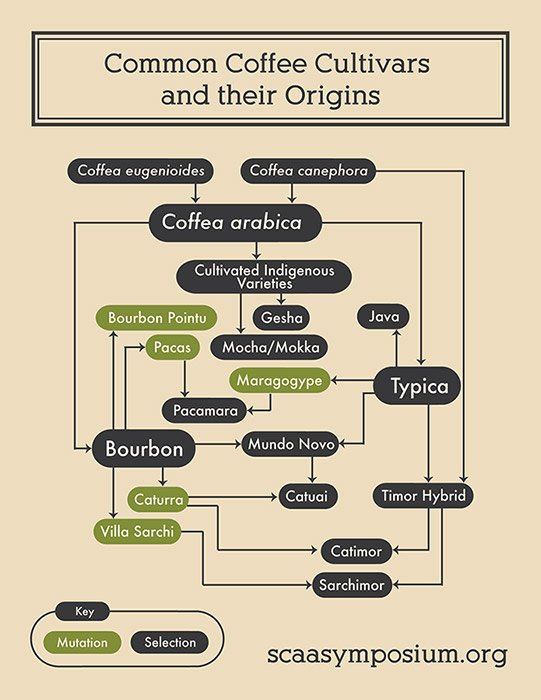Coffee A,B,C – varieties (III)
When you read all those cool and informative labels and descriptions you can find on coffee packaging and websites, it can get quite confusing trying to understand them. In another article we’ll take a look at all kinds of certifying labels, but now we are going to take a closer look at varieties. It’s hard enough to get a sense of the differences between Arabica and Robusta, or between African, Colombian, Indonesian, Central American and other coffees, but what about words like “pacarmara” and “maragogype”, varietals, cultivars and … and so on!
So let’s try to get some order in this variety thing and start with the genus level of the taxonomic hierarchy (genus -> species -> subspecies -> variety -> form)
The first one is an easy one, because the genus is coffee or Coffea:
Genus Coffea: The botanical genus comprised of over 120 individual species, of which the following 3 are the most important ones:
Coffea eugenioides: Indigenous to the highlands of East Africa, including the Democratic Republic of Congo, Rwanda, Uganda, Kenya and western Tanzania. Famously known to be one of the two diploid parent plants of C. arabica. It has a lower caffeine content than Arabica.
Coffea canephora: The botanical species name for Robusta coffee. The other one of the two diploid parent plants of C. arabica. It has a higher productivity and caffeine content than Arabica.
Coffea arabica: The botanical species name for Arabica coffee, otherwise written as C. arabica. Originated in the forests of Ethiopia and South Sudan, then famously spread throughout the world for the production of its seeds.
As you can see in all those taxonomy trees, after the species there are a lot of subspecies, derived through selective breeding or natural selection of coffee plants.
After the subspecies we come at the variety level of the taxonomy tree!
While there is tremendous variability encountered in both wild and cultivated coffee plants, there are a few varieties and cultivars that are commercially important due to various unique and inherent traits such as disease resistance and fruit yield. These unique traits are what producers use to select breeds when developing crops. Therefore, at a micro level, breed selection is critical to the success of a producer and is one of the key components of cup quality. Below we can find a simple diagram of the most common commercial varieties and their origings:

Source: scaasymposium.org
Technically speaking, a botanical variety is a rank in the taxonomic hierarchy below the rank of species and subspecies and above the rank of form. It will have an appearance distinct from other varieties, but will hybridize freely with those other varieties.
Cultivars are cultivated varieties of a species originating through human influence. These could be selected from existing cultivated stock or from wild populations. It is a systematic group of cultivated plants that is clearly distinct, uniform, and stable in its characteristics and which, when propagated with the appropriate methods, retain the same characteristics.
In normal day speech both terms are used both and indistinctively, but using the term cultivar freely can have legal implications. At the form level we see all kind of small variations within the variety level.
- Taxonomy: Domain: Eukaryota, Kingdom: Plantae, Division : Anthophyta or Magnoliophyta, Class: Magnoliopsida, Subclass: Asteridae, Order: Rubiales. Family: Rubiaceae, Genus: Coffea
- Fort he full species list see here.
Previous article from coffee series you can find under tag #cafescope.
You can see them all here.
Article was also published on Cafescope
This post has received a 0.52 % upvote from @drotto thanks to: @petrvl.